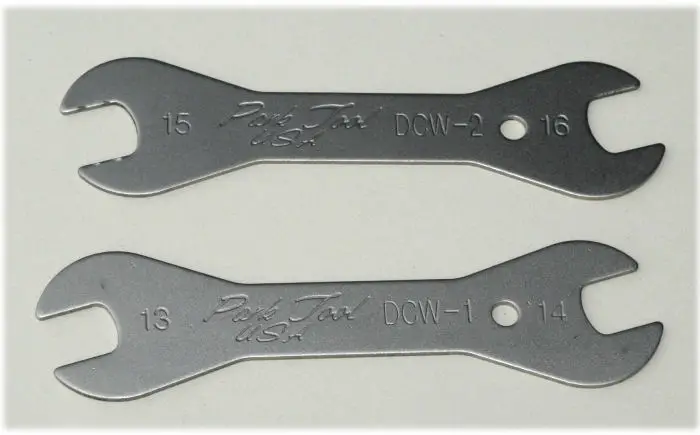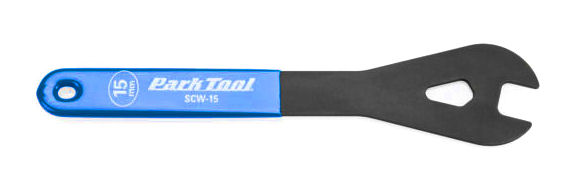

|
|
Tweet |

Some special bicycle tools are time- and labor- savers for jobs that could be done with standard tools; other special tools are absolutely necessary to do certain jobs. Among the essential special tools are cone wrenches. No standard tools can take their place.
Cone wrenches are similar to ordinary double-ended open-end wrenches , except that they are much thinner. A typical good quality 14-millimeter open-end wrench or six-inch adjustable wrench is about seven millimeters (0.28-inch) thick; cheap wrenches are thicker still. Cone wrenches, however, are usually only two millimeters (0.08-inch) thick.

In most cases, a standard open-end or adjustable wrench can be used for cone locknuts, but the cones themselves can be adjusted only with a cone wrench, because of narrow flats and close clearances.
Tightening a hub locknut against the cone
Cone wrenches usually come in 13 x 14-millimeter, 15 x 16-millimeter, and 17 x 18-millimeter sizes. If you intend to do your own maintenance, you should have at least one and preferably two of each size needed for your hubs. The safest way to buy cone wrenches is to ride your bicycle to a well-stocked bicycle shop and check the fit as you are buying the wrenches.
Cheap tools are never a bargain, and this is especially true of cone wrenches. Because of their extreme thinness for the nut sizes they fit, cone wrenches must be made of especially high-quality steel to stand up to the normal stresses that they will be subjected to in use. Inferior cone wrenches will bend, often the first time that they are used, and so become useless.
![]()
![]()
As with so many other bicycle tools and parts, Campagnolo is the standard for comparison. I have been using my Campagnolo wrenches for 12 or 13 years now, and they still fit as well as they did when they were new. I bought the Campagnolo wrenches after going through several sets of cheap French cone wrenches in just a few' months of professional use. At that time, I could find nothing else that would hold up to serious use.
In the past few years, however, quite serviceable cone wrenches have become available from American and Japanese manufacturers at reasonable prices. In general, you will get better quality tools if you buy them individually, rather than buying a pre-packaged "bicycle tool kit."
Schwinn makes particularly good cone wrenches for shop use. They are single-ended, with a comfortable plastic-coated handle. Unfortunately, since they are single ended, you need to buy ten of them to get two each of the five common sizes. (I have yet to find a need for the 18-millimeter end of my 17 x 18-millimeter wrench).
[The brand recommendations above are very out-of-date. My current favorite is the Park laser-cut (black finish) shop model.]

There are times when two cone wrenches of the same size are essential -- for instance, Campagnolo Record rear hubs use a 14-millimeter wrench for both the cones and the locknuts; the locknuts have narrow flats and taper in such a way that you must use a cone wrench for the locknut as well as for the cone.
Even when two identical cone wrenches are not essential, they are a great aid in adjusting the cones quickly and exactly.
If you do not have two of each needed size, to make even the smallest change in the cone adjustment, you must first loosen the locknut, then adjust the cone, then re tighten the locknut. If you get the cone adjustment just right but the locknut is not sufficiently tight, tightening the locknut will throw the cone adjustment off. Careful cone adjustment by this technique is a very time-consuming process of trial and error.
If you have two wrenches of each needed size, the fine adjustment can be done much more quickly and easily! First, get the cones in roughly correct adjustment, with the locknuts fairly tight. Now, if the cone adjustment is too tight, put a wrench on each cone and back the cones away from each other.
This will simultaneously loosen the cone adjustment and further tighten the locknuts. If the cone adjustment is a bit too loose, put a wrench on each locknut and tighten them together. This will tighten both the cone adjustment and the locknuts at the same time. This approach will enable you to make very small adjustments to the cones without loosening the locknuts.
There is a supposedly non-rotating washer between each cone and locknut, which you might think would keep this system from working, but it does not in practice, as long as you start with a reasonably good rough adjustment.
The correct adjustment for solid-axle hubs is to get the cones tight enough to reduce play to a minimum without causing the axle to bind when turned. You should first judge the freeness of the bearing when the cones are too loose, so that there is a little bit of play.
Pretend that you are a safecracker and that the axle is the knob of a safe. Hold the axle by a cone locknut very gently with your fingertips. Revolve the axle slowly several revolutions. Do this by turning your wrist, not by rolling the axle in your fingers. You should feel almost no resistance, and no unevenness in the rotation.
If there is roughness or unevenness with the bearings adjusted loose, it means that your bearing surfaces are damaged, your axle is bent, or there is foreign matter (dirt) in the bearings.
If it turns smoothly and without resistance with the cones loose, remember how that feels. Tighten the cones bit by bit until you feel slightly increased resistance, then back the adjustment off just enough to get rid of the resistance.
At this point, there should be no noticeable play in the axle. if you cannot eliminate almost all of the play from the axle without causing the bearings to bind, the hub needs to be cleaned and repacked, possibly with some new parts.
Some hubs with sealed cartridge bearings have double locknuts on each end. The axle generally has a flange inboard each bearing. The bearing's inner race is clamped between this flange at the inside and the inner locknut at the outside. The cartridges use radial-contact bearings: that is, the bearing balls ride in the bottom of rounded grooves in the inner and outer raceways, rather than on angled surfaces as in cup and cone bearings.
(How do they get the bearing balls in, you may ask? By placing the races eccentrically from one another, so there is a big space on one side -- introducing bearing balls only on that side, and then spacing the bearing balls evenly and snapping a retainer into place to hold them in position. )
Despite the locknuts, this kind of hub is non-adjustable. It should turn freely, and if installed in a wheel, there should be a very slight amount of play at the rim. If it binds, that is probably because the bearing balls are riding on the side of the raceway. This can occur if the cartridge is not properly seated due to dirt or burrs, or if the axle is not exactly right for the hub.
![]()
![]()
If you have quick-release hubs, this is just the starting point. When the quick-release skewer is tightened, it slightly compresses the axle, making the cone adjustment tighten. If your cones are perfectly adjusted with the skewer loose, they will become too tight once the wheel is installed and the quick release is tightened.
To compensate for this, cones on quick-release hubs must be adjusted so that there is a little bit of play when they are not on the bicycle. The very final tightening is done with the quick-release skewer When the cones are properly adjusted on a quick-release wheel, there should be slight bearing play if the quick-release skewer is only partially tightened. This play should just disappear once the quick-release is fully tightened. My article on cone adjustment describes a special tool that compresses the axle, avoiding the need for trial-and-error adjustment.
Axle compression is a particular problem with some cartridge-bearing hubs, because these are non-adjustable. The better cartridge-bearing hubs have an extra-rigid large-diameter axle.
Because cone wrenches come in generally useful sizes, and are very light, it is often tempting to use them for other purposes, such as saddle adjustments and tightening axle nuts or even pedals. Resist this temptation! These tools are only for cones, and any other use constitutes abuse of a fine tool. All of these other uses require substantially more torque than is needed for cone adjustments, and these thin wrenches are not made for such heavy use. Good quality tools should last a lifetime if properly cared for.
![]()
![]()
![]()
![]()
Last Updated: by Harriet Fell